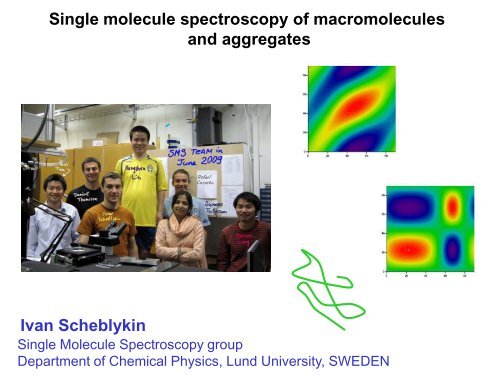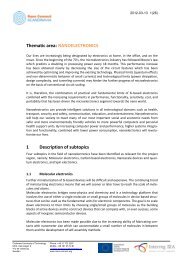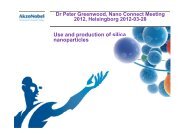Single molecule spectroscopy of macromolecules and aggregates ...
Single molecule spectroscopy of macromolecules and aggregates ...
Single molecule spectroscopy of macromolecules and aggregates ...
Create successful ePaper yourself
Turn your PDF publications into a flip-book with our unique Google optimized e-Paper software.
<strong>Single</strong> <strong>molecule</strong> <strong>spectroscopy</strong> <strong>of</strong> macro<strong>molecule</strong>s<br />
<strong>and</strong> <strong>aggregates</strong><br />
Ivan Scheblykin<br />
<strong>Single</strong> Molecule Spectroscopy group<br />
Department <strong>of</strong> Chemical Physics, Lund University, SWEDEN
Sample<br />
Very low surface concentration<br />
Laser excitation<br />
Ivan Scheblykin<br />
5 µ<br />
<strong>Single</strong> <strong>molecule</strong> <strong>spectroscopy</strong>
Ivan Scheblykin
Wide-field excitation <strong>and</strong> detection,<br />
The same as in a normal epi-fluorescence microscope.<br />
Vacuum or<br />
gas chamber<br />
or<br />
cryostat (5K-300K)<br />
Ivan Scheblykin<br />
CCD<br />
Camera<br />
Objective lens<br />
Excitation<br />
blocking filter<br />
Images with 10 ms time resolution<br />
Movie – 100 frames per second<br />
Intensity(t), Fluorescence Spectrum (t)<br />
Fluorescence lifetime (20 ps time resolution)<br />
Polarization microscopy<br />
Excitation clean-up filter<br />
Excitation light:<br />
Ar-ion laser<br />
514 nm<br />
488 nm<br />
458 nm<br />
Ti-Sph<br />
750 – 850 nm<br />
Diode lasers (CW <strong>and</strong> pulsed 50 ps)<br />
405 nm<br />
480 nm<br />
640 nm<br />
He-Ne laser<br />
546 nm<br />
592 nm<br />
633 nm
Ivan Scheblykin<br />
Dye <strong>molecule</strong><br />
Structure,<br />
Energy transfer ?<br />
Molecular aggregate<br />
Luminescent polymer chain<br />
(conjugated polymer)<br />
SMS for material sciences !<br />
Fluorescence Polarization
Traditional characteristic <strong>of</strong> polarization - Modulation Depth<br />
Excitation<br />
polarization<br />
M<br />
=<br />
I<br />
I<br />
max<br />
max<br />
−<br />
+<br />
I<br />
I<br />
min<br />
min<br />
I max<br />
I min<br />
Emission<br />
Modulation in<br />
EXCITATION<br />
Rotated linear<br />
M ex<br />
Circular<br />
Rotated analyzer<br />
(linear polarization)<br />
Modulation in<br />
FLUORESCENCE<br />
M fl
<strong>Single</strong> <strong>molecule</strong><br />
λ/2<br />
CCD camera Ivan Scheblykin<br />
I T<br />
Rotated linear<br />
Rotated analyzer<br />
ϕ (linear polarization)<br />
ex ϕ fl<br />
I T (ϕ ex , ϕ fl )<br />
Polarization ”portraites” <strong>of</strong> <strong>molecule</strong>s<br />
2D polarization single <strong>molecule</strong> imaging<br />
Emission<br />
polarization<br />
angle<br />
2D plot = Topology <strong>of</strong> the <strong>molecule</strong><br />
Excitation polarization angle<br />
Energy transfer<br />
between differently oriented<br />
chromophores<br />
O. Mirzov, R. Bloem, P. R. Hania, D. Thomsson, H. Lin, <strong>and</strong> I. G. Scheblykin, Small 5 (2009) 1877
Conjugated polymers<br />
Ivan Scheblykin<br />
Organic electronics<br />
Poly-phenylene-vinylene derivative<br />
MEH-PPV<br />
Flexible displays<br />
Transistors ...<br />
Spin coating from a diluted solution<br />
chains<br />
In polymer host matrix<br />
Quartz
“Chromophore size”<br />
~ 3-5 nm<br />
Ivan Scheblykin<br />
5 ÷ 20 nm<br />
5 - 500 “chromophores”<br />
Polymer chain – ensemble <strong>of</strong> chromophores
Modulation depth correlation plot<br />
Absorption by en ensemble,<br />
Emission from a single chromophore<br />
(energy funnel)<br />
1<br />
<strong>Single</strong><br />
chromophore<br />
M<br />
=<br />
I<br />
I<br />
max<br />
max<br />
−<br />
+<br />
I<br />
I<br />
min<br />
min<br />
M EM<br />
0 1<br />
Absorption <strong>and</strong> Emission<br />
by a large ensemble <strong>of</strong><br />
chromophores<br />
M EX<br />
M ex – geometry <strong>of</strong> the whole object<br />
M em – geometry <strong>of</strong> the emitting sites
Modulation depth correlation plot<br />
Pr<strong>of</strong>. Harry Anderson, Oxford, UK<br />
H.Anderson et al, Adv. Funct. Mater. 2008,18, 3367<br />
M EM<br />
1.0<br />
0.8<br />
0.6<br />
0.4<br />
PFBV.Me, Modulation Depth<br />
1.74 nm<br />
0.2<br />
0.0<br />
0.0 0.2 0.4 0.6 0.8 1.0<br />
M EX<br />
N ≈ 9 monomer units<br />
Emitting chromophores are<br />
different from the<br />
absorbing chromophores
When N→∞ , M EX → M EM<br />
H.Lin et al, JACS 2008<br />
The whole object absorbs light<br />
Continues distribution <strong>of</strong> the dipole moment orientations is assumed<br />
M EX<br />
Only N chomophores emit light<br />
N dipoles are chosen r<strong>and</strong>omly from the given distribution<br />
M EM
Number <strong>of</strong> chromophores<br />
1,0<br />
1,0<br />
N=2 4<br />
Y Axis Title<br />
0,8<br />
0,6<br />
0,4<br />
Y Axis Title<br />
0,8<br />
0,6<br />
0,4<br />
0,2<br />
N2<br />
0,2<br />
N4<br />
6<br />
Y Axis Title<br />
0,0<br />
0,0<br />
0,0 0,2 0,4 0,6 0,8 1,0 0,0 0,1 0,2 0,3 0,4 0,5 0,6 0,7 0,8 0,9 1,0<br />
X Axis Title<br />
X Axis Title<br />
1,0<br />
1,0<br />
0,8<br />
0,8<br />
0,6<br />
0,6<br />
0,4<br />
0,4<br />
Y Axis Title<br />
8<br />
0,2<br />
0,2<br />
M EM<br />
1,0<br />
0,8<br />
0,6<br />
0,4<br />
PFBV.Me, Modulation Depth<br />
Y Axis Title<br />
N6<br />
N8<br />
0,0<br />
0,0<br />
0,0 0,2 0,4 0,6 0,8 1,0 0,0 0,2 0,4 0,6 0,8 1,0<br />
X Axis Title<br />
X Axis Title<br />
1,0<br />
1,0<br />
N10<br />
N12<br />
10 12<br />
0,8<br />
0,6<br />
0,4<br />
0,4<br />
Y Axis Title<br />
0,8<br />
0,6<br />
0,2<br />
0,2<br />
0,2<br />
0,0<br />
0,0 0,2 0,4 0,6 0,8 1,0<br />
M EX<br />
Y Axis Title<br />
0,0<br />
0,0<br />
0,0 0,2 0,4 0,6 0,8 1,0 0,0 0,2 0,4 0,6 0,8 1,0<br />
1,0<br />
X Axis Title<br />
1,0<br />
X Axis Title<br />
N14<br />
N18<br />
0,8<br />
0,6<br />
0,4<br />
Y Axis Title<br />
0,8<br />
14 16<br />
0,6<br />
0,4<br />
0,2<br />
0,2<br />
0,0<br />
0,0<br />
0,0 0,2 0,4 0,6 0,8 1,0 0,0 0,2 0,4 0,6 0,8 1,0<br />
X Axis Title<br />
X Axis Title<br />
Y Axis Title<br />
1,0<br />
1,0<br />
N18<br />
N20<br />
F9<br />
F10<br />
18 20<br />
0,8<br />
0,6<br />
0,4<br />
Y Axis Title<br />
0,8<br />
0,6<br />
0,4<br />
0,2<br />
0,2<br />
Y Axis Title<br />
0,0<br />
0,0<br />
0,0 0,2 0,4 0,6 0,8 1,0 0,0 0,2 0,4 0,6 0,8 1,0<br />
1,0<br />
X Axis Title<br />
1,0<br />
X Axis Title<br />
N22<br />
N24<br />
F11<br />
F12<br />
0,8<br />
0,6<br />
0,4<br />
Y Axis Title<br />
0,8<br />
22 24<br />
0,6<br />
0,4<br />
0,2<br />
0,2<br />
0,0<br />
0,0<br />
0,0 0,2 0,4 0,6 0,8 1,0 0,0 0,2 0,4 0,6 0,8 1,0<br />
X Axis Title<br />
X Axis Title
0.0 0.2 0.4 0.6 0.8 1.0<br />
1.0<br />
0.8<br />
250K<br />
0.0 0.2 0.4 0.6 0.8 1.0<br />
1.0<br />
200K<br />
0.8<br />
0.6<br />
0.6<br />
0.4<br />
0.2<br />
0.0<br />
MEH-PPV<br />
single chains<br />
(toluene)<br />
MEH-PPV<br />
<strong>aggregates</strong><br />
(200 nm)<br />
0.4<br />
0.2<br />
0.0<br />
1.0<br />
300K<br />
1.0<br />
Huge <strong>aggregates</strong> <strong>of</strong><br />
chlorophyll <strong>molecule</strong>s.<br />
0.8<br />
0.8<br />
200 nm long<br />
M F<br />
0.4<br />
0.2<br />
MEH-PPV<br />
from aged<br />
solution<br />
0.0<br />
0.0 0.2 0.4 0.6 0.8 1.0<br />
M E<br />
M F<br />
O. Mirzov, R. Bloem, P. R. Hania, D. Thomsson, H. Lin, <strong>and</strong> I. G. Scheblykin, Small 5 (2009) 1877<br />
M em<br />
0.6<br />
0.4<br />
0.2<br />
0.0<br />
0.0 0.2 0.4 0.6 0.8 1.0<br />
M ex<br />
Very good internal organization<br />
In collaboration with Pr<strong>of</strong>. Alfred Holzwarth,<br />
Mülheim an der Ruhr, Germany<br />
0.6
Can we have more information than just polarization modulation depth ?<br />
Yes!<br />
We just need to learn how to read 2D plots<br />
Conjugated polymer MEH-PPV
ϕ ex<br />
ϕ fl<br />
Ivan Scheblykin<br />
λ/2<br />
I T<br />
CCD camera<br />
I R<br />
I T<br />
I R<br />
We have the total intensity I=I T +I R<br />
Normalized 2D plot: I T /( I T +I R )<br />
ET<br />
I T<br />
I T /I<br />
better signal/noise<br />
enhanced polarization pattern<br />
Small 5 (2009) 1877
Perfect energy transfer to a fixed set <strong>of</strong> emitting chromophores<br />
Paul Barbara, 1997<br />
Energy funneling in conjugated polymers<br />
Yes or No ?<br />
Funnel<br />
Set <strong>of</strong> absorbing<br />
chromophores<br />
Energy transfer<br />
Funnel<br />
Set <strong>of</strong> emitting<br />
chromophores is<br />
INDEPENDENT<br />
on excitation<br />
Excitation<br />
polarization<br />
I T /I<br />
ϕ emission<br />
ϕ Excit<br />
I<br />
I<br />
I<br />
I<br />
T<br />
R<br />
T<br />
T<br />
=<br />
=<br />
+<br />
IT<br />
+ I<br />
2<br />
2<br />
( 1−<br />
mex<br />
cos [ ϕex<br />
+ α ]) 1−<br />
mem<br />
cos [ ϕem<br />
+ β ]<br />
2<br />
2<br />
( 1−<br />
mex<br />
cos [ ϕex<br />
+ α ]) 1−<br />
mem<br />
sin [ ϕem<br />
+ β ]<br />
2<br />
I = 2 ( 1−<br />
m ) 1−<br />
m cos [ ϕ + α ]<br />
R<br />
R<br />
=<br />
1<br />
2<br />
( )<br />
( )<br />
(<br />
ex ex<br />
)<br />
( 1−<br />
m<br />
2<br />
cos ϕ + β )<br />
em<br />
( 1−m<br />
) [ ]<br />
em<br />
em<br />
em
Two independent chromophores<br />
Several chromophores +<br />
some ET between them<br />
ET<br />
ET<br />
Ensemble <strong>of</strong><br />
independent chromophores<br />
(solution)<br />
Funnel<br />
ϕ emission<br />
photoselecton<br />
Polarization <strong>of</strong> emission is<br />
DEPENDENT on polarization <strong>of</strong><br />
excitation<br />
ϕ Excit<br />
NO photoselecton<br />
Polarization <strong>of</strong> emission is<br />
INDEPENDENT on<br />
polarization <strong>of</strong> excitation
Continuously distributed dipoles<br />
0 0 – 90 0 I T /I I T<br />
Energy Transfer is 0, no funnel
Continuously distributed dipoles<br />
0 0 – 90 0 I T /I I T<br />
Energy Transfer is 0.6 to funnel at 0 0
Continuously distributed dipoles<br />
0 0 – 90 0 I T /I I T<br />
Energy Transfer is 0.6 to funnel at 45 0
Continuously distributed dipoles<br />
0 0 – 90 0 I T /I I T<br />
Energy Transfer is 0.6 to funnel at 90 0
Continuously distributed dipoles<br />
0 0 – 90 0 I T /I I T<br />
Energy Transfer is 0.6 to funnel at 135 0
Polymer chain
I T /I<br />
I T<br />
Energy Transfer = 0<br />
Polymer chain
I T /I<br />
I T<br />
Energy Transfer = 0.4<br />
Polymer chain
I T /I<br />
I T<br />
Energy Transfer = 0.8<br />
Polymer chain
I T /I<br />
I T<br />
Energy Transfer = 0.9<br />
Polymer chain
I T /I<br />
I T<br />
ET=1 Energy Transfer = 1<br />
Polymer chain
Almost 100% energy transfer to a funnel<br />
Experiment<br />
Fitting
Almost 100% energy transfer to a funnel<br />
Experiment<br />
Fitting
2 polarized regions (2 dipoles)<br />
Experiment<br />
Fitting
Independend chromophores + some funneling<br />
Experiment<br />
Fitting
I T (ϕ ex , ϕ fl )<br />
Polarization ”portraites” <strong>of</strong> <strong>molecule</strong>s<br />
2D polarization single <strong>molecule</strong> imaging<br />
Emission<br />
polarization<br />
angle<br />
2D plot = Topology <strong>of</strong> the <strong>molecule</strong><br />
Excitation polarization angle<br />
Energy transfer<br />
between differently oriented<br />
chromophores<br />
Molecular aggregate<br />
Luminescent macro<strong>molecule</strong>s<br />
O. Mirzov, R. Bloem, P. R. Hania, D. Thomsson, H. Lin, <strong>and</strong> I. G. Scheblykin, Small 5 (2009) 1877
SMS group<br />
Daniel Thomsson<br />
Rafael Camacho<br />
Dr. Yuxi Tian<br />
Former members<br />
Dr. Hongzhen Lin<br />
Dr. Oleg Mirzov<br />
Acknowledgements<br />
Conjugated polymers<br />
Pr<strong>of</strong>. Harry Anderson, Oxford, UK<br />
Giuseppe Sforazzini<br />
Chemical Physics<br />
Pr<strong>of</strong>. Villy Sundström<br />
Pr<strong>of</strong>. Tönu Pullerits













